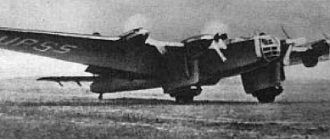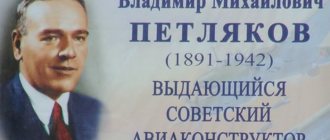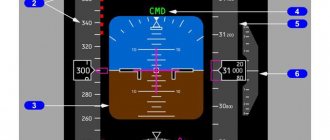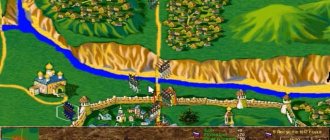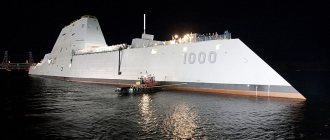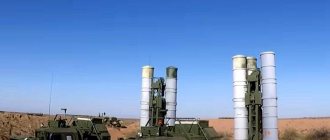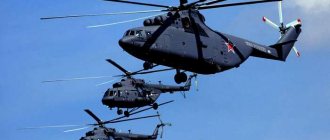American bombers are part of the elite strategic aviation. Along with submarine missile carriers and ground-based intercontinental missiles, they form the backbone of the nuclear triad. This power is considered the determining force in the global containment of world military disasters.
American bombers of World War II
You may be interested in: Tire side cut: repair or replacement? Can it be repaired?
The B-17 FF line of attack aircraft was produced at the production facilities of Boeing, Douglas, and Lougheed. Production dates from 1936-1945. All 7,000 vehicles produced had an all-metal structure with fabric covering of the tail and camouflaged landing gear.
These combat aircraft were also operated by the British Air Force. Twelve of the captured units flew in Luftwaffe squadrons as Dornier DO 200s.
Technical characteristics of the specified American bomber:
- dimensions/wing span – 22.7/5.8/31.6 m;
- empty/take-off weight – 16.4/29.7 t;
- types of motors - “Cyclone” 1820-97 with a power parameter of 1200 hp. With.;
- capacity of fuel tanks – up to 13.7 thousand liters;
- maximum speed – 525 km/h;
- flight range – up to 5.7 thousand km;
- armament - 13 Browning machine guns with a caliber of 12.7 mm, bomb load weight - 2.3 tons;
- team composition – 10 people.
You may be interested in:Names of Russian weapons and interesting facts
Attack aircraft and bombers | USA
Attack aircraft A-36A Apache (Invader)
The attack aircraft, developed on the basis of the P-51 Mustang fighter, was produced in 1942-1943. A total of 500 cars were produced. The aircraft is also known as the A-36 Mustang. Vehicle performance characteristics: length – 9.8 m; height – 3.7 m; wingspan - 11.3 m; take-off weight – 4.5 t; engine – Allison V-1710 with a power of 1,325 hp; maximum speed – 587 km/h, cruising speed – 402 km/h; practical range – 885 km; practical ceiling – 7,700 m; armament - six 12.7 mm machine guns; bomb load - 454 kg; crew – 1 person.
Boeing B-17B bomber
Boeing B-17C bomber
Boeing B-17E bomber
Boeing B-17F bomber
Boeing B-17G bomber
The B-17 Flying Fortress series of heavy long-range bombers was produced by Douglas and Lockheed in 1936-1945. in the following production versions: B-17B, B-17C, B-17E, B-17F and B-17G. The aircraft of all-metal construction had a fabric tail covering and retractable landing gear. A total of 7 thousand cars were produced. The aircraft was also used by the UK, 12 of the 40 aircraft captured by the Wehrmacht as a result of forced landings after restoration repairs flew with the Luftwaffe with German markings under the designation "Dornier Do 200". Vehicle performance characteristics: length – 21 – 22.7 m; height - 4.7 - 5.8 m; wingspan - 31.6 m; wing area – 132 m²; empty weight - 12.5 - 16.4 tons, take-off weight - 20.9 - 29.7 tons; engines – four Wright R-1820-97 “Cyclone” with a power of 1,200 hp; volume of fuel tanks - 9.5 - 13.7 thousand liters; rate of climb – 4.6 m/s; maximum speed - 470 - 520 km/h, cruising speed - 291 - 400 km; practical range - 3,200 - 5,790 km; practical ceiling – 10,850 – 11,300 m; armament - thirteen 12.7 mm M-2 Browning machine guns; bomb load - 2.3 tons; crew - 9 - 10 people.
Boeing B-29 Superfortress bomber
The heavy strategic bomber was produced by Bell and Martin since 1943. From this aircraft in August 1945, atomic bombs were dropped on the Japanese cities of Hiroshima and Nagasaki. The aircraft was an all-metal cantilever mid-wing with a high aspect ratio wing and a fuselage of circular cross-section. The airframe was assembled from aluminum profiles and sheets. The aircraft was equipped with remote-controlled weapons, three pressurized cabins for crew members, a three-post landing gear with twin wheels, and two bomb bays. A total of 3.9 thousand cars were produced. Performance characteristics of the vehicle: length – 30.2 m; height – 8.5 m; wingspan – 43 m; wing area -159.8 - 161.3 m²; empty weight - 31.8 - 32.4 tons, take-off weight - 61.2 - 63.5 tons; engines - four Wright R-3350 with a power of 2,200 hp; volume of fuel tanks – 35.4 thousand liters; rate of climb – 8.3 m/s; maximum speed – 643 km/h, cruising speed – 547 km; practical range - 3,320 - 6,380 km; practical ceiling – 9,700 – 12,000 m; run length – 1,590 m, run length – 680 m; twelve 12.7 mm machine guns; bomb load - 9 tons; crew - 11 people.
Consolidated B-24 Liberator bomber
The heavy bomber was produced by Douglas, North American and Ford Motor in 1940-1945. in the following serial modifications: B-24A, B-24D, B-24E, B-24G, B-24H, B-24J, B-24L and B-24M. The modifications differed in engines, weapons and equipment. The aircraft had a tricycle retractable landing gear with a nose gear. A total of 18.5 thousand cars were produced. The aircraft was also used by Great Britain. Performance characteristics of the vehicle: length – 19.5 – 20.6 m; height - 5.5 - 5.7 m; wingspan - 33.5 m; wing area – 97.4 m²; empty weight - 13.7 - 17.2 tons, take-off weight - 24.3 - 35.2 tons; engines - four Pratt & Whitney R-1830 with a power of 1,200 hp; rate of climb – 5.2 m/s; maximum speed - 470 - 488 km/h, cruising speed - 322 - 367 km/h; practical range - 3,400 - 3,700 km; practical ceiling – 8,500 – 9,700 m; armament - ten to eleven 12.7 mm Browning M-2 machine guns or four 12.7 mm machine guns and eight 7.62 mm Browning machine guns and four 20 mm Hispano cannons; bomb load - 3.6 tons; crew – 7-10 people.
Consolidated B-32 Dominator bomber
The heavy bomber was produced in 1944-1945. It was a monoplane with a cantilever high wing and retractable three-post landing gear. The aircraft had a two-fin tail and a high-aspect wing mounted high. A total of 118 vehicles were produced. Vehicle performance characteristics: length – 25.3 m; height –10.1 m; wingspan - 41.2 m; wing area – 132.1 m²; empty weight - 27 tons, take-off weight - 50.5 tons; engines - four Wright R-3350 with a power of 2,200 hp; volume of fuel tanks – 35.4 thousand liters; rate of climb – 3.4 m/s; maximum speed – 575 km/h, cruising speed – 505 km; practical range – 4,815 km; practical ceiling – 11,000 m; ten 12.7 mm Browning M2 machine guns; bomb load - 9.1 tons; crew - 9 - 10 people.
Douglas B-18 bomber
Douglas B-18A bomber
The medium bomber was produced in 1936-1938. in the following variants: V-18, V-18-A, V-18AM and V-18V. A total of 350 cars were produced. The aircraft was used in Brazil and Canada. Vehicle performance characteristics: length – 17.6 m; height – 4.6 m; wingspan - 27.3 m; wing area – 89.7 m²; empty weight - 7.4 tons, take-off weight - 12.6 tons; engines - two Wright R-1820-53 Cyclone 9 with a power of 1,000 hp; maximum speed – 346 km/h, cruising speed – 269 km/h; practical range – 1,930 km; practical ceiling – 7,285 m; armament - three 7.62 mm machine guns; bomb load - 3 tons; crew – 6 people.
Douglas B-23 Dragon bomber
The B-23 medium bomber was an improved version of the B-18 and was produced in 1939-1940. It had a retractable tricycle landing gear with a tail wheel, a more powerful engine and weapons, and an additional tail machine gun. A total of 38 vehicles were produced. Vehicle performance characteristics: length – 17.8 m; height – 5.6 m; wingspan - 28 m; wing area – 92 m²; empty weight – 8.7 t, take-off weight – 14.7 t; engines - two Wright R-2600-3 Cyclone 14 with a power of 1,600 hp; maximum speed – 454 km/h, cruising speed – 338 km/h; practical range – 2,200 km; practical ceiling – 9,600 m; armament - three 12.7 mm machine guns and three 7.62 mm machine guns; bomb load - 2 tons; crew - 4 - 5 people.
Douglas A-20A bomber
Douglas A-20C bomber
Douglas A20K bomber
Douglas A-20G bomber
The Douglas A-20 Havoc/DB-7 Boston medium bomber was produced since 1939. A total of 7.5 thousand vehicles were produced, which had different designations depending on the country of use. In the USA, the aircraft had the following modification designations: A-20, A-20A, A-20B, A-20C, A-20G, A-20H, A-20J and A-20K. The aircraft was also used in the UK (DB-7A, Boston Mk-I, Boston Mk-II, Boston Mk-III, Boston Mk-IV and Boston Mk-V), USSR (A-20) and France (modifications of DB-7 and DB-73). Vehicle performance characteristics: length – 14.5 m; height – 5.4 m; wingspan - 18.7 m; wing area – 43.2 m²; empty weight - 6.8 - 7.3 tons, take-off weight - 10.7 - 12.3 tons; engines – two Wright R-2600-A5/R-2600-23 with a power of 1600/1700 hp; rate of climb – 610 m/m; maximum speed – 544 km/h, cruising speed – 338 km/h; practical range – 1,700 km; practical ceiling –7,600 – 8,400 m; armament - eight 12.7 mm machine guns; bomb load - 1.8 tons; crew - 3 - 4 people.
Douglas A-24B attack aircraft
The attack aircraft is based on the SBD-5 deck dive bomber. In 1943-1944. 615 vehicles were produced for the army. Vehicle performance characteristics: length – 10 m; height – 3.9 m; wingspan - 12.7 m; wing area – 30.2 m²; empty weight – 3 t, take-off weight – 4.7 t; engine – Wright R-1820-60 Cyclone with 1,200 hp; maximum speed – 410 km/h, cruising speed – 290 km/h; practical range – 1,500 km; practical ceiling – 8,200 m; armament - two 12.7 mm Browning M-2 machine guns and two 7.62 mm machine guns; bomb load - 544 kg; crew – 2 people.
Douglas A-26B Invader bomber
Douglas A-26C bomber
The medium bomber was produced in 1944-1945. in two modifications A-26B and A-26C. It was an all-metal mid-wing with a three-post landing gear with a nose support. The aircraft had remote-controlled machine gun turrets. A total of 2.4 thousand cars were produced. The aircraft was also used by Great Britain. Vehicle performance characteristics: length – 15.2 m; height – 5.6 m; wingspan - 21.3 m; wing area – 50.2 m²; empty weight - 10.4 tons, take-off weight - 15.8 tons; engines - two Wright R-2800-27 with a power of 2,000 hp; rate of climb – 6.4 m/s; maximum speed – 571 km/h, cruising speed – 457 km/h; practical range – 2,250 km; practical ceiling – 6,700 m; armament - ten to sixteen 12.7 mm machine guns; bomb load - 2.7 tons; crew – 3 people.
Flying Fortress B-40 bomber
The heavy bomber was a modification of the B-17F and was produced by Lockheed Vega in 1943. It was intended for escort and fire protection of groups of bombers. The aircraft was additionally equipped with two turrets, armor was added, and the bomb load was increased. A total of 25 cars were produced. Vehicle performance characteristics: length – 22.8 m; height – 5.8 m; wingspan - 31.6 m; wing area – 132 m²; empty weight - 17.8 tons, take-off weight - 28.8 tons; engines - four Wright R-1820-65 Cyclone with 1,200 hp; maximum speed – 470 km/h, cruising speed – 315 km; practical range – 3,600 km; practical ceiling – 8,900 m; fourteen 12.7 mm Colt-Browning M-2 machine guns, ammunition - 11.1 thousand rounds, bomb load - 2.7 tons; crew – 9 people.
Lexington B-34 bomber
The medium bomber was created on the basis of the Lockheed Model 18 Lodestar transport aircraft and was produced since 1941. It was an all-metal monoplane with retractable landing gear with a tail wheel and a two-tail fin. A total of 200 B-34 aircraft, 101 B-34A aircraft and 13 B-34B aircraft were produced. Vehicle performance characteristics: length – 15.7 m; height – 3.7 m; wingspan – 20 m; wing area – 51.1 m²; empty weight - 7.8 tons, take-off weight - 12.6 tons; engines - two Pratt Whitney R-2800 with a power of 2,000 hp; maximum speed – 507 km/h, cruising speed – 371 km; practical range – 4,200 km; practical ceiling – 7,300 m; armament - six 7.62 mm machine guns and four 12.7 mm Browning M-2 machine guns; bomb load - 1.4 tons; crew – 4 people.
Lockheed Hudson Mk I bomber
Lockheed Hudson Mk III bomber
Lockheed Hudson Mk IIIA bomber
Lockheed Hudson Mk VI bomber
The Lockheed A-28(29) Hudson medium bomber was produced in 1938-1942. commissioned by Great Britain. The aircraft was produced in the following modifications: Mk-I, Mk-II, Mk-III, Mk-IIIA, Mk-IV, Mk-IVA, Mk-V and Mk-VI, differing in engines and weapons. In the USA the aircraft was designated as A-28, A-29A/B. The bomber was also used by Australia, Canada and New Zealand. The aircraft was an all-metal twin-engine mid-wing with spaced tail and advanced wing mechanization. A total of 2.6 thousand cars were produced. Vehicle performance characteristics: length – 13.5 m; height – 3.6 m; wingspan – 20 m; wing area – 51.1 m²; empty weight – 5.4 t, take-off weight – 8.4 t; engines – two GR-1820-G102A/GR-1820-G205A with a power of 1,100/1,200 hp; rate of climb – 6.2 m/s; maximum speed – 397 km/h, cruising speed – 328 km/h; practical range – 3,150 km; practical ceiling – 7,400 m; armament - four or five 7.62 mm machine guns; bomb load - 0.4 - 0.8 t; crew – 3 people.
Lockheed B-37 bomber
The medium reconnaissance bomber was produced in 1942 on the basis of the Lockheed Lodestar transport aircraft. A total of 18 vehicles were produced. Vehicle performance characteristics: length – 15.7 m; height – 3.7 m; wingspan – 20 m; wing area – 51.1 m²; empty weight - 8.2 tons, take-off weight - 13.4 tons; engines - two Wright R-2600 with a power of 1,700 hp; maximum speed - 480 km/h, cruising speed - 319 km; practical range – 2,100 km; practical ceiling – 6,800 m; four 7.62 mm machine guns and five 12.7 mm Browning M-2 machine guns; bomb load - 0.9 t; crew – 5 people.
Martin YB-10 bomber
Martin B-10B Bomber
The average three-seat twin-engine bomber was produced in 1933-1937. in the following versions: YB-10 (with R-1820-25 engines with a power of 675 hp) and B-10B (with R-1820-33 engines with a power of 775 hp). A total of 121 cars were produced. Vehicle performance characteristics: length – 13.6 m; height – 4.7 m; wingspan - 21.5 m; wing area – 63 m²; empty weight – 4.4 t, take-off weight – 6.6 t; rate of climb – 448 m/m; maximum speed – 343 km/h, cruising speed – 311 km; practical range – 2,000 km; practical ceiling – 7,370 m; thirteen 7.62 mm machine guns; bomb load – 1 t; crew - 3 - 4 people.
Martin Model 139WH-1 bomber
Martin Model 139WH-3 bomber
The medium bomber was an export version of the B-10 and was supplied to the Dutch East Indies in two modifications: Model 139WH-1/2 (with two canopies) and Model 139WH-3/3A (with one canopy). The aircraft was produced in 1936-1938. A total of 206 vehicles were produced. Aircraft were also delivered to China (5 aircraft), Argentina (22), Turkey (20) and Thailand (6). Vehicle performance characteristics: length – 13.6 m; height – 4.7 m; wingspan - 21.5 m; wing area – 63 m²; empty weight – 4.4 t, take-off weight – 6.6 t; engines - two - Wright R-1820-33 Cyclone / GR-1820-G5 / GR-1820-G102 with a power of 775/1100/1200 hp; rate of climb – 448 m/m; maximum speed – 343 – 388 km/h, cruising speed – 311 km; practical range – 2,000 km; practical ceiling – 7,370 m; armament - thirteen 7.62 mm machine guns; bomb load – 1 t; crew - 3 - 4 people.
Martin Bomber - 167F (167-A3)
Martin 187 Baltimore bomber
The medium bomber was produced in 1940-1941. ordered by Great Britain in modifications Mk-I/Mk-II/Mk-III/Mk-IIIA/Mk-V, differing in engines and weapons. The plane was a modification of the Martin Mariland. A total of 1.6 thousand cars were produced. Performance characteristics of the vehicle: length – 14.8 m; height – 5.4 m; wingspan - 18.7 m; wing area – 50 m²; empty weight – 7 tons, take-off weight – 10.3 tons; engines - two - Wright R-2600-10 Cyclon 14 with a power of 1,660 hp; rate of climb – 12 m/s; maximum speed – 491 km/h, cruising speed – 362 km/h; practical range – 1,740 km; practical ceiling – 7,100 m; four 7.7 mm machine guns and two 7.62 mm machine guns; bomb load - 0.9 t; crew – 4 people.
Martin B-12 Bomber
The medium bomber was a modernized version of the B-10 and was produced in 1933-1934. It differed from its predecessor by an increased fuel supply and engines. A total of 32 cars were produced. Vehicle performance characteristics: length – 13.6 m; height – 4.7 m; wingspan - 21.5 m; wing area – 63 m²; empty weight – 4.3 t, take-off weight – 5.9 t; engines - two Pratt & Whitney R-1690-11 Hornet with a power of 700 hp; fuel tank capacity – 1.4 thousand liters; maximum speed – 341 km/h, cruising speed – 266 km/h; practical range – 2,000 km; practical ceiling – 7,370 m; armament - three 7.62 mm machine guns; bomb load – 1 t; crew - 3 - 4 people.
Martin B-26A Marauder bomber
Martin B-26B bomber
Martin B-26C bomber
Martin B-26F bomber
Martin B-26G-11 bomber
Martin B-26G-6 bomber
The medium bomber was produced in 1941-1945. in the following serial modifications: B-26, B-26A, B-26B, B-26C, B-26F and B-26G. It was a twin-engine, seven-seat all-metal cantilever monoplane with a three-wheeled retractable landing gear. A total of 5.3 thousand cars were produced. Under the Lend-Lease agreement, 522 bombers were delivered to the UK. Vehicle performance characteristics: length – 17.8 m; height – 6.6 m; wingspan - 21.6 m; wing area – 61.2 m²; empty weight – 10.9 t, take-off weight – 16.8 t; engines - two Pratt & Whitney R-2800-43 with a power of 1,920 hp; volume of fuel tanks – 2.7 thousand liters; rate of climb – 366 m/s; maximum speed - 434 - 460 km/h, cruising speed - 344 - 358 km/h; practical range – 3,200 km; practical ceiling – 6,600 m; armament - eleven 12.7 mm Browning machine guns; practical bomb load - 1.8 tons; crew – 7 people.
Maryland Mk-I (167F) bomber
Maryland Mk-II bomber
The Martin Type 167 medium reconnaissance bomber was produced from 1940 and delivered to the UK (designated Maryland Mk-I/Mk-II, 201 vehicles delivered) and France (designated 167-A3, 249 vehicles delivered). It was an all-metal cantilever monoplane with retractable landing gear and a fixed tail wheel. A total of 450 cars were produced. Performance characteristics of the vehicle: length – 14.2 m; height – 5.1 m; wingspan - 18.7 m; wing area – 50 m²; empty weight - 4.8 - 5.7 tons, take-off weight - 6.9 - 7.6 tons; engines - two - R-1830-SC3G/R-1830-SC4G with a power of 1000/1200 hp; rate of climb – 12 m/s; maximum speed - 467 - 508 km/h, cruising speed - 400 km/h; practical range – 2,100 – 2,800 km; practical ceiling – 9,500 m; armament - six 7.7 mm Browning or Vickers machine guns; bomb load - 0.9 t; crew – 3 people.
Mitchell B-25 bomber
Mitchell B-25A bomber
Mitchell B-25B bomber
Mitchell B-25C bomber
Mitchell B-25D bomber
Mitchell B-25G bomber
B-25H bomber
B-25J Bomber
The medium bomber was produced since 1941 in the following serial modifications: B-25, B-25A, B-25B, B-25C, B-25D, B-25G, B-25H, B-25J. It was an all-metal, cantilever monoplane. The landing gear had a third wheel in the forward fuselage. The aircraft's tail is double-finned and cantilever. Elevator and direction rudders with a metal set and fabric covering. A total of 9.9 thousand cars were produced. The aircraft was delivered to the UK, Canada, China and the USSR. Vehicle performance characteristics: length – 15.5 – 16.1 m; height – 4.8 m; wingspan - 20.6 m; wing area – 57, m²; empty weight - 8.1 - 9.6 tons, take-off weight - 12.9 - 15.9 tons; engines – two Wright R-2600 “Cyclone” with a power of 1,700 - 1,850 hp; volume of fuel tanks - 2.6 - 4.7 thousand liters; rate of climb – 4 m/s; maximum speed - 442 - 509 km/h, cruising speed - 370 - 422 km/h; practical range – 2,100 – 2,500 km; practical ceiling – 7,600 – 8,200 m; armament - five to twelve 12.7 mm Colt-Browning machine guns or a 75 mm M4 cannon and six 12.7 mm machine guns; bomb load - 1.4 - 2.7 tons; crew - 5 - 6 people.
Northrop BT-1 bomber
The light dive bomber "Northrop BT" was produced in 1936, which is a subsidiary division. A total of 55 vehicles were produced. Vehicle performance characteristics: length – 9.7 m; height – 3.6 m; wingspan - 12.7 m; wing area – 29.6 m²; empty weight – 2.1 t, take-off weight – 3.3 t; engine – Pratt & Whitney R-1535-94 with a power of 825 hp; rate of climb – 6.5 m/s; maximum speed – 357 km/h, cruising speed – 309 km/h; practical range – 1,852 km; practical ceiling – 7,710 m; armament - 12.7 mm machine gun and 7.62 mm machine gun; bomb load - 454 kg; crew – 2 people.
Bomber Vultee A-31 Vengeance Mk-III
Vultee A-31 Vengeance Mk-I bomber
The dive bomber was produced in 1941-1944. ordered by Great Britain (under the designation Vengeance Mk-III) and “Northrop” (under the designation Vengeance Mk-I). In the USA, aircraft designated A-31 were used only as training aircraft. The aircraft was an all-metal cantilever mid-wing with a split wing on two equal-strength spar beams. A total of 1.5 thousand cars were produced. Vehicle performance characteristics: length – 12.1 m; height – 4.7 m; wingspan - 12.8 m; wing area – 30.8 m²; empty weight – 3.9 t, take-off weight – 6.4 t; engine – Wright R-2600-19 “Cyclone” with a power of 1,600 hp; maximum speed – 442 km/h, cruising speed – 378 km/h; practical range – 2,100 km; practical ceiling – 6,800 m; armament - five 12.7 mm machine guns; bomb load - 0.7 t; crew – 2 people.
A-35A Vengeance attack aircraft
The aircraft was an improved version of the A-31 and was produced in 1941. It differed from its predecessor by replacing the 7.62 mm machine guns with 12.7 mm ones. A total of 99 vehicles were built. Aircraft were also delivered to France.
A-35В Vengeance attack aircraft
The aircraft was the result of the modernization of the A-35A carried out by Northrop in 1942. A total of 830 aircraft were produced and converted from the A-35A.
Under the designation Vengeance Mk-IV (manufactured by Vultee) and Vengeance Mk-IA (manufactured by Northrop), the vehicles were supplied to the UK and Australia. 29 vehicles were sent to Brazil and France. Vehicle performance characteristics: length – 12.1 m; height – 4.7 m; wingspan - 12.8 m; wing area – 30.8, m²; empty weight – 4.4 t, take-off weight – 7.8 t; engine – Wright R-2600 “Cyclone” with a power of 1,700 hp; maximum speed – 450 km/h, cruising speed – 370 km/h; practical range – 2,200 km; practical ceiling – 6,800 m; armament - seven 12.7 mm machine guns; bomb load - 0.9 t; crew – 2 people. Share to:
Boeing B-29
Another American bomber aircraft has been manufactured by Boeing, Martin, and Bell corporations since 1943. It was this model that attacked Hiroshima and Nagasaki with atomic weapons in the summer of 1945. The design of the vehicle is a mid-wing with a solid cantilever body made of metal, equipped with an extension wing and a rounded fuselage.
The aircraft was assembled from sheet profiles. The ammunition was controlled at a distance, the design included three pressurized cabins, a chassis with three struts, double wheels and a pair of bomb bays. A total of 3.9 thousand units of this modification were manufactured.
You may be interested in: Critical age in men: concept, periods and features
TTX:
- overall dimensions – 30200/8500 mm;
- wing span - 43000 mm;
- empty/take-off weight – 32.4/63.5 t;
- power plants - Wright 3350 motors (4 pieces) with a power of 2.2 thousand hp. With.;
- capacity of fuel tanks – 35 thousand liters;
- speed threshold – 643 km/h;
- flight range – 6380 km;
- armament - 12.7 mm machine gun mounts (12 pieces), bomb stock - 9000 kg;
- team composition – 11 people.
Preparing for a collision
The B-2's flights to Iceland and the Azores during its current stay in Europe suggest that these aircraft can operate with minimal ground support from a number of "non-conventional" forward-deployed bases throughout the European region. Previously, B-2s, as I mentioned, flew to bomb Yugoslavia, Afghanistan, Iraq and Libya from their “home” Whiteman Air Force Base in Missouri, but the use of forward deployment bases will allow for an increase in the intensity of combat missions.
Flights to the Norwegian Sea, Iceland and the Arctic Circle indicate that the United States is testing the combat use of
B -2 against Russian military installations on the Kola Peninsula - primarily, bases of nuclear-powered ballistic missile submarines (SSBNs) and storage facilities for nuclear warheads and ballistic missiles. submarine missiles (SLBMs) of the Northern Fleet.
It is curious that, unlike the B-52H, which repeatedly flew over the Baltic Sea, Poland and the Baltic states, approaching Kaliningrad and St. Petersburg, as well as over the Black Sea near the Crimea, B-2 bombers in these areas neither before nor during this visit was not noticed. And not because of the notorious “invisibility” to radars. Most likely, the Americans do not want to expose these aircraft to the radars of Russian air defense systems and fighter-interceptors, which would allow Russia to find out the real degree of their stealth in the radar, infrared and ultraviolet ranges.
Consolidated B-24 "Liberator"
The heavy American strategic bomber was manufactured by Consolidated, North American, Douglas, and Ford Motor corporations. Years of production: 1940-45. Several variations came into the series, differing in power plants, weapons, and equipment. The design of the machine is a one-piece body with a three-legged transformable chassis. More than 18 thousand units were produced in the series.
Options:
- dimensions – 20600/5700 mm;
- wing size taking into account span – 33500 mm;
- empty/take-off weight – 17.2/35.2 t;
- engines - four Pratt & Whitneys with 1.2 thousand hp. With.;
- maximum speed – 488 km/h;
- flight range – 3.7 thousand km;
- ammunition - 12.7 mm (10 pieces) and eight 7.62 mm Browning machine guns, four 20 mm guns, bomb reserve - 3600 kg;
- number of team members – up to 10.
Stratospheric travelers
The atmosphere in which airplanes fly is divided into two dissimilar parts, two different “habits.” The lower part of the atmosphere is called the troposphere. It accumulates the energy and violence of solar heat, with the help of which almost all weather phenomena occur. The troposphere is characterized by dynamics and turbulence; it is saturated with various vertical movements of the environment and clouds of all types. At an altitude of 10-12 kilometers, the troposphere is separated by a rather noticeable boundary from another space located above - the stratosphere.
The stratosphere is structured differently: it is laid out in even layers that do not mix dynamically. That is why it is called the stratosphere, from the Latin stratum - “layer”. There is practically no vertical movement in it, so the flight in it is usually calm, without shaking, and the low air density allows it to develop high speed. The calmness of the stratosphere saves fuel for fending off various disturbances, because the wings, stabilizers and fins create their force in a deflected position, and this is always additional air resistance. For short ranges this is not so significant, but at strategic ranges there are no trifles.
In addition, the absence of turbulence reduces the load on the aircraft and reduces the accumulation of metal fatigue, extending operational life. Therefore, the stratosphere for strategic aircraft is the basis for long (and multiple) ranges. However, they use this basis in different ways. Both of our heroes use the stratosphere as an echelon to cover strategic distances, as a calm and fast highway along which they can rush until they approach enemy airspace. And this is where the differences begin to appear. The Tu-160 can continue to move at supersonic speed, while the B-2 will descend and sneak as close to the terrain as possible, trying to completely blend into the terrain.
- The deeply modernized Tu-160M strategic bomber has completed factory tests
Russia has completed factory tests of the deeply modernized Tu-160 strategic bomber, equipped with new engines. There are new tests ahead of the car.naked-science.ru
The maximum flight altitude of both aircraft is approximately the same: 15,200 meters for the B-2 and 16,000 meters for the Tu-160. Why exactly so much? The fact is that the stratosphere begins at different heights at different latitudes of the Earth. At the poles, the lower boundary of the stratosphere lies at an altitude of eight to nine kilometers. At the equator, the troposphere, pumped up by the equatorial rays of the Sun, bubbles more intensely, accelerating the ascending currents to greater heights, and pushes the stratosphere higher, to altitudes of 15-17 kilometers. The maximum flight altitude of the B-2 corresponds to the ability to fly in the stratosphere at any latitude, remaining in its quiet layers and saving fuel by minimizing control efforts.
B-32 "Dominator"
This American bomber is a heavy monoplane with a cantilever high-mounted wing and a landing gear with three struts. The vehicle had a double keel tail and an elongated wing. A total of 118 units of this series were produced.
Characteristics:
- dimensions – 25300/10100 mm;
- wing span – 41200 mm;
- empty/take-off weight – 27000/50500 kg;
- motors - four Wright R-3350 engines with a power rating of 2.2 thousand hp. With.;
- speed limit – 575 km/h;
- range – 4.8 thousand km;
- combat reserve - 12.7 mm Browning machine guns (10 pcs.), bomb set amounted to 9.1 tons;
- team – 10 people.
Production
The conclusion of a contract with Boeing for large-scale production of the B-29 bomber (Project 345) was evidence of its high authority among the US Air Force. This authority was ensured by the successful pre-war projects of Boeing heavy aircraft, brought to large-scale production (B-17, B-307) and the accumulated experience of variant design of numerous promising initiative developments, in accordance with the changing requirements of the customer (Air Force). The company's authority was reinforced by positive reviews of variant developments of modifications of the large-scale B-17 bomber in the direction of continuously improving its combat characteristics and the first successes of the massive combat use of B-17 bombers in the European theater.
In March 1942, on the initiative of the command of the US Army Air Forces, taking into account an increase in the order by more than 1000 units, for the final assembly of B-29 bombers, in addition to the old Boeing plant in Wichita (Kansas) and the new Boeing plant in Renton (Washington). ), two enterprises belonging to large aircraft manufacturing corporations were additionally attracted: the Bell-Atlanta plant in Marietta (Georgia) - and the Martin plant in Omaha (Nebraska) -. For the production of airframe components (wing, engine nacelles, fuselage, empennage, landing gear), enterprises of related companies were involved: Chrysler, Hudson, Goodyear, Briggs, Murray and Cessna. In addition, for the production and supply of all other components and assemblies for the B-29, enterprises throughout the United States were involved:
- In 1944, it was planned, after the production of B-17 bombers in Seattle had been curtailed, to organize the production of aircraft there in a modified version of the B-29S-VO (the order for 5,000 units was canceled at the end of the war).
- The Boeing plant in Wichita - from September 1943 to October 1945, produced a total of 1,620 units. in version B-29;
- The Boeing plant in Renton produced only the B-29A variant;
- The Bell-Atlanta plant in Marietta produced a total of 357 units from February 1944 to January 1945. in the B-29 version, and switched to the production of a modified version of the B-29B;
- The Martin plant in Omaha produced a total of 536 units from mid-1944 to September 1945. in the B-29 version.
A total of 3,627 units were collected and produced at all enterprises. B-29 of all main variants: XB-29 - 3 units, YB-29 - 14 units, B-29, B-29A and B-29B.
Ordered in 1944 by Boeing (as it turned out - the final modified version - B-29D-BN, with the installation of new, more powerful engines) - it was mass-produced since 1947 - only at the Boeing plant in Renton, under the designation - B-50A-BN.
Serial production of the B-29 aircraft was launched at the Boeing plants in Seattle and Wichita, as well as at the Martin (Glenn L. Martin Company) and Bell (Bell Aircraft Co.) plants. A total of 3,970 B-29 aircraft of all modifications were built.
Douglas B-18A and A-20G
The Douglas B-18A medium category combat aircraft was manufactured in 1936-38. 350 copies were produced in three main variations. The vehicle was also operated by the Canadian and Brazilian Air Forces.
Options:
- dimensions – 17600/4600 mm;
- wing span – 27300 mm;
- empty/take-off weight – 7.4/12.6 t;
- power units – a pair of Wright R “Cyclone” engines with one thousand hp. With.;
- speed threshold – 346 km/h;
- flight range – 1.9 thousand km;
- the ammunition load includes three 7.62-mm machine gun sets, the bomb supply is 3000 kg;
- team composition – 6 people.
You may be interested in: Air rifles "Smersh": types, equipment, device, photo
Another medium-category bomber, the A-20, was produced from 1939. 7.5 thousand units of this series were produced. Countries in which the aircraft was operated: USA, France, Britain.
Options:
- dimensions – 14500/5400 mm;
- wing size taking into account the span - 18700 mm;
- empty/take-off weight – 6800/12300 kg;
- motors - a pair of Wright R-2600 engines with a power of 1.7 thousand hp. With.;
- maximum speed – 540 km/h;
- combat reserve - eight machine guns with a caliber of 12.7 mm, bomb weight - 1800 kg;
- team – 4 people.
Is stealth really that effective?
These and other measures have led to a radical reduction in the radar and thermal signature of the B-2, but just how stealthy it actually is remains a closely guarded mystery. The range of estimates of its EPR ranges from 0.0014 to 0.1 m² (for comparison: for the B-52 bomber it is about 100 m², for a conventional fighter of no importance it is from 3 to 12 m²). More modest figures are also mentioned - from 0.05 to 0.5 m² in frontal projection. In any case, the B-2's ESR is much lower than that of conventional aircraft without the use of stealth technology.
This does not make it completely invisible to radars and electro-optical systems, but it significantly reduces the detection distance and, therefore, the time remaining for air defense systems to react.
On the other hand, information leaked to the media that during tests in the early 1990s. The onboard radar N‑019 (developed by NPO Phazotron) of the MiG-29 fighter, received by the United States from Germany from the arsenal of the former GDR, could quite see the B-2 even against the background of the earth. But since then, Russian radar developments have by no means stood still. We see B-2 for meter range radars as well. For example, it was successfully detected by the old P-14 radar, which I encountered during my military service in the anti-aircraft missile forces (ZRV) back in the early 1980s, and which was not considered modern even then.
Military expert of the Arsenal of the Fatherland magazine Alexey Leonkov noted that stealth technologies manifest themselves most effectively in the X-band radio waves (centimeter wavelength), in which most air defense radars and aircraft radars operate today. Much worse technologies for reducing ESR work in the L-band - decimeter, in which a whole line of radars has been created in Russia. He also pointed out that Russian target detection systems also include optical-electronic systems that complement the capabilities of the radar by recognizing targets in the visible optical range, as well as in the IR and UV spectra. By the way, at a number of international aviation exhibitions, the B-2 was consistently captured and accompanied by thermal imagers in the infrared range. The downside of the B-2's stealth is that after each flight, the aircraft's radar-absorbing coating requires updating using toxic materials and, in connection with this, special protective suits for the airfield crew.
In any case, the question of the real ability of the B-2 to break through strong air defense at low altitude and strike with free-fall weapons remains open - in practice, it has never dealt with such air defense. On the other hand, Russian air defense has never dealt with such targets in practice. I would like to hope that the effectiveness of American Stealth bombers against Russian air defense will never be tested in reality, because otherwise, recalling the famous quote from Albert Einstein[10], those who remain alive after this will discuss combat effectiveness already stones and not at all on the Internet.
American modern bombers
The modern US Air Force is armed with the B-52, B-2 (Spirit) and B-1B (Lancer) strategic bombers. The latest model was developed specifically for launching nuclear attacks on enemy territory. However, in the 90s, the military aircraft was withdrawn from the army. B-1B Lancer aircraft are often compared to the Russian Tu-160. It is worth noting that they are inferior to the latter in size. According to available information, 12 B-2 vehicles and 73 modifications of B-52 are in combat readiness.
Development of V-2
The B-2 Spirit strategic bombers are the most modern aircraft of their kind in the US Air Force, although they are far from young (average age is just over 24 years). The development of a new stealth bomber under the Advanced Technology Bomber (ATB) program began in 1979. Initially, the Strategic Air Command (SAC) of the US Air Force intended to use the ATB to break through at high altitudes to objects located on the territory of a potential enemy with strong air defense (read: the USSR) .
Their primary targets were to be mobile installations of intercontinental ballistic missiles (ICBMs), and after their destruction - large groups of ground forces[3]
.
After evaluating the proposals received, the development contract was awarded to two teams: Northrop[4]/Boeing (Senior Ice proposal) and Lockheed/Rockwell (Senior Peg proposal). On October 20, 1981, the Northrop/Boeing team was declared the winner of the competition[5]. Due to the appearance in the USSR of the latest S-300 air defense systems, which did work “from above” even in stealth mode without large losses, the project was temporarily frozen in 1983 and then changed to ensure long-term low-altitude flight (up to 60 m above the level surface) in the mode of automatic contour following.
In 1987, the ATB received the official designation B-2. On November 22, 1988, the B-2 prototype was first publicly demonstrated at Air Force Plant 42 in Palmdale, California, and made its first flight on July 17, 1989. The aircraft was piloted by Northrop test pilot Bruce J. Hinds and US Air Force Colonel Richard S. Koch.
BoeingB-52 Stratofortress
This long-range American bomber was created during the Cold War. It belongs to one of the symbols of a superpower and is the basis of the US strategic air force. The aircraft is capable of carrying nuclear warheads; its first flight was made back in 1952.
It is planned to spend about $12 billion on modernization of the aircraft. According to experts, each unit in this series is capable of flying for 83 years (until 2040). A total of 744 copies were produced. The aircraft is made according to a standard aerodynamic configuration with an elevated wing placement. Eight power units are located in twin engine compartments. The wing type is an all-metal caisson element with a pair of spars.
The crew of the American B-52 bomber includes six people. The upper cabin is low, designed to accommodate the commander, co-pilot and electronic warfare instructor. The keel can be folded to the right for storage in a hangar, the chassis is a bicycle design, includes four main struts and two supports at the ends of the wing. The engines are Pratt and Whitney-57 turbofan engines.
Characteristics:
- length/height – 49.05/12.4 m;
- wing span - 56.39 m;
- take-off weight – 221.5 tons;
- maximum speed – 1013 km/h;
- range of action in combat conditions - 7.73 thousand km;
- run - 2.9 km;
- in service - a 20-mm Vulcan cannon, bomb load - 27.2 tons.
Design Features
The B-2 strategic bomber is designed according to the “flying wing” aerodynamic design. Aircraft designer Jack Northrop, the founder of the Northrop company, which later built the B-2, began work on it back in 1939. In the 1940s. The company built six piston heavy bombers XB-35 and YB-35 according to this scheme (nine more aircraft were not completed), but they were not accepted into service. Immediately after the war, two YB-35s were converted into YB-49 jets, but they too suffered the same fate[8].
Northrop returned to the “flying wing” design when developing the B-2, since its flat shape without sharp kinks and interface lines with the absence of a vertical fin and other protruding elements reduces the radar cross-section (RCS) and radar signature of the aircraft [9].
The aircraft design makes extensive use of composite materials to create a radio-absorbing “honeycomb” structure (the airframe of the aircraft consists of 80% composite materials). All surfaces of the B-2 that could be irradiated by enemy radar, and those internal surfaces that could produce any reflected signal, are covered with radar-absorbing materials. The cockpit glazing consists of special glasses that provide external and internally diffuse reflection of radiation (both from the enemy radar and from the aircraft’s own equipment). The air intake ducts are S-shaped to reduce the radar signal reflected from the compressor turbine blades. Four General Electric F118‑GE‑110 afterburning turbofan engines have wedge-shaped output devices to reduce the reflection area in the infrared spectrum. To disperse the contrail, chlorine-containing acid is injected into the exhaust gas plume. The design and operating modes of the AN/APQ‑181 radar provide for measures to both reduce the reflected radar signal from its elements and the likelihood of its signal being detected by enemy passive means. It is turned on to clarify the location of targets immediately before striking for a short time in a narrow beam pattern mode.
B-2 Spirit
These American supersonic bombers are the most high-tech and expensive in the world. The price of one copy exceeds two billion dollars. The first models were released back in the 80s of the last century. After 10 years, the program was mothballed due to the high cost of the project, which was beyond the capabilities of even the United States.
During the specified period, 21 units were produced. The planes are made using stealth technology. This figure is significantly lower than the compact modifications of the F-22 and F-35. The B-2 is equipped only with free-falling bombs, which reduces the effectiveness of using vehicles against an enemy equipped with modern air defense systems. For example, the domestic S-400 air defense system can easily detect Spirit. As a result, these aircraft are considered rather controversial bombers in terms of effectiveness in a nuclear conflict.
The aircraft in question is made of the “flying wing” type and does not have vertical tail. The structure is mostly made of aluminum and titanium alloy with the participation of carbon fiber components with increased thermal stability.
Performance characteristics of the V-2 aircraft:
- length/height – 20.9/5.45 m;
- wing span - 52.4 m;
- empty/take-off weight – 56.7/168.4 t;
- power unit - four General Electric F118-GE turbofan engines;
- speed threshold – 1.01 thousand km/h;
- practical range – 18.5 thousand km;
- Crew composition: 3 people.
Combat experience
The B-2 was first used in combat during NATO's aggression against Yugoslavia on March 23, 1999. The bombers flew to bomb Yugoslavia from their base in Missouri, performing 30-hour non-stop flights with mid-air refueling. Although they flew only 50 sorties, they dropped 11% of all NATO bombs and destroyed 33% of all selected targets in the first eight weeks of the war. It was from the B-2 that five JDAM guided bombs were dropped on May 7, 1999, which hit the Chinese embassy in Belgrade. In this case, Xinhua News Agency journalist Shao Yunhuan, People's Daily journalist Xu Xinghu and his wife Zhu Yi were killed, and another 27 Chinese were injured.
NATO claimed that the target of the bombing was the nearby Federal Supply Administration building, which dealt, among other things, with the export and import of arms, and that the embassy, whose building was built in 1993, was hit by accident due to outdated maps.
In the age of space and space intelligence, such justifications are, to put it mildly, very puzzling. The United States paid China compensation of $4.5 million, which was divided among relatives of the dead and wounded, as well as another $28 million for damage to the embassy building. China, in turn, paid $2.87 million for damage caused to US diplomatic missions in China during anti-American protests after the bombing.
Subsequently, B-2s were used in combat operations in Afghanistan, Iraq and Libya, and not a single aircraft was lost. On the Internet you can find claims that two B-2 bombers were shot down in Yugoslavia (specifically referred to as the “Spirit of Missouri” and “Spirit of Washington”). However, these aircraft repeatedly appeared in photographs taken later than 1999. And it is impossible to hide the loss of such expensive registered aircraft - except perhaps to disguise a combat loss as a plane crash. But in 1999, B-2s did not crash, and the first and only crash occurred, as I already mentioned, only in 2008, many years after the end of the war in Yugoslavia. So we can’t talk about losses, but battle damage could well have occurred. But in order to prove or disprove this, it is necessary to carefully track the flight history of each B-2, which is beyond the scope of this article.
